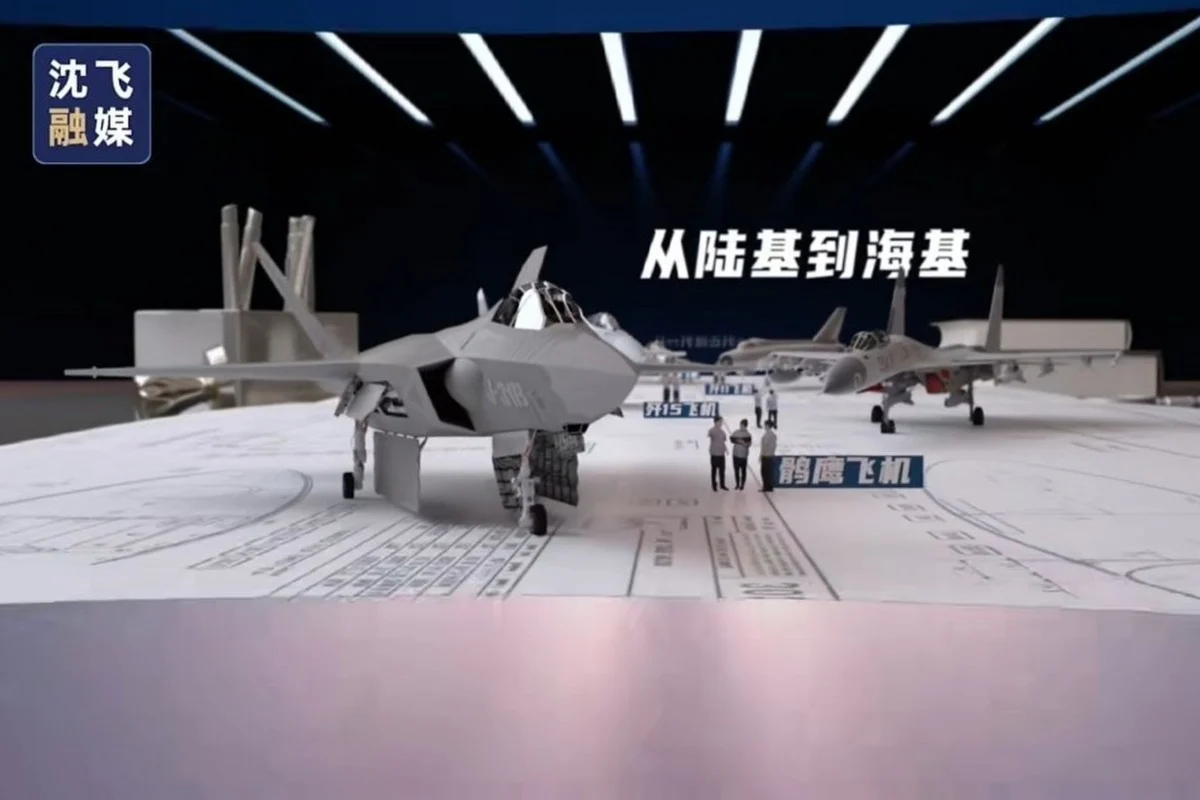Shenyang Aircraft Corporation (SAC), a state-owned subsidiary of one of China’s top defense contractors, has recently released a video showcasing the new J-31B fifth-generation fighter jet.
In a newly released video, SAC showcased the front side of a computer-generated prototype of the J-31B. The aircraft, prominently marked with “J-31B” and captioned as “Gyrfalcon,” features a side weapon bay carrying two missiles.
The medium-sized stealth fighter, widely promoted as FC-31 for the export market, has been referred to by domestic media and commentators as the J-31 or J-35. However, it never had an official name until now.
The jet has been in the spotlight for several months due to its carrier-based potential. The new J-31B model appears larger than the original FC-31, which was first introduced a decade ago.
The video indicates that the J-31B boasts a payload capacity comparable to heavy fighters and excels in structural optimization, space utilization, and engine performance.
China’s Shenyang Aircraft Corporation Unveils J-31B Fifth-Generation Fighter.
The aircraft intended to be carrier based is equipped with side weapon bays, each capable of carrying two missiles. pic.twitter.com/rpTRLjnoob
— Yusuf Unjhawala 🇮🇳 (@YusufDFI) July 4, 2024
The new footage further suggests that the J-31B can carry at least two missiles in its side weapon bays. This distinguishes the J-31B from the US F-22 Raptor and China’s own J-20, which also have side weapon bays but can only accommodate one missile per side.
Additionally, it boasts a main weapon bay similar to that of the J-20, allowing it to carry at least four PL-12 medium-range air-to-air missiles.
Chinese experts cited by the South China Morning Post said that the transformation of the FC-31 into the J-31 signifies that it has met the formal requirements for military service and has received an official designation.
Despite the advancements, questions remain about the exact role and deployment of the J-31B. Fu Qianshao, a Beijing-based military analyst and retired PLA Air Force equipment analyst, noted that the code “B” might indicate the existence of several variants of the J-31.
However, he noted that it is still unclear whether the B variant will be carrier-based, land-based, or for export. On the other hand, another expert quoted by the SCMP argued that the J-31B appears more likely to be commissioned into the PLA Air Force rather than the Navy.
This is because the front landing gear shown in the video is single-wheeled, which is typically more suited to land-based aircraft rather than carrier-based ones.
Nonetheless, the J-31B’s official revelation marks a significant step in China’s military aviation advancements, signaling the country’s growing capabilities in developing advanced stealth fighter jets.
With ongoing evaluations and potential modifications, the role of the J-31B in China’s defense strategy will become clearer in the near future.
Evolution And Export Market Potential
Developed as a fifth-generation stealth fighter for the People’s Liberation Army (PLA) and potential export markets, China’s FC-31/J-35 stealth fighter has seen substantial development and testing since its inaugural flight in 2012.
First introduced to the public at the 2014 Zhuhai Air Show, the aircraft is often compared to Lockheed Martin’s F-35 Lightning II, reflecting its advanced capabilities.
In recent years, the fighter jet has garnered attention primarily because of its carrier-based potential. It was speculated that the J-35 variants would be deployed on PLA Navy’s third and most advanced carrier, the Fujian, featuring electromagnetic catapult systems.
However, recent observations of a J-35 mockup being tested on the Liaoning aircraft carrier, which features ‘ski jump’ takeoff ramps, indicate that it may also be modified for use on current carriers.
Further, last month, EurAsian Times reported that China is also progressing on a land-based version of the FC-31/J-35 stealth fighter.
Photographs of the prototype revealed major design differences from the carrier-based J-35, highlighting continuous evolution and suggesting potential export opportunities.

Additionally, China’s efforts to market the FC-31 internationally have gained traction. In January 2024, Pakistan’s Air Chief Marshal Zaheer Ahmed Baber Sidhu announced plans to procure the FC-31 to modernize its air force.
This announcement was heavily marketed by Chinese media as a win-win cooperation, opening the international market for Chinese aircraft.
Earlier this year, China displayed a model of the FC-31 at the World Defence Show in Saudi Arabia. A Chinese official at the show indicated that the FC-31 was not yet in service with the PLA Air Force but would soon be operational.
The commissioning of the J-31 would make China the second country, after the United States, to have two types of stealth aircraft. The J-20 fighter jets would complement the J-31, potentially pairing with the J-15 as a carrier-based aircraft.
China’s participation in the Saudi defense show also indicated a marketing push towards Middle Eastern countries, with the UAE emerging as a possible future buyer.
This follows a halted deal during Donald Trump’s presidency, where the UAE had agreed to purchase 50 F-35s from the US in exchange for establishing diplomatic ties with Israel.
The deal was paused after President Joe Biden took office in 2021 due to concerns over the UAE’s relationship with China and the risk of technology leaks.
Therefore, the unveiling of the J-31B marks a key milestone in China’s stealth fighter capabilities. Its continuous evolution and growing international interest highlight Beijing’s commitment to expanding its military and export potential.
- Contact the author at ashishmichel(at)gmail.com
- Follow EurAsian Times on Google News




